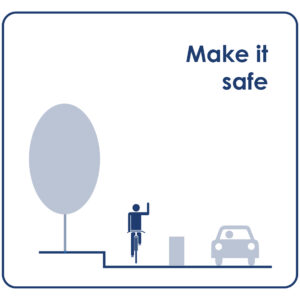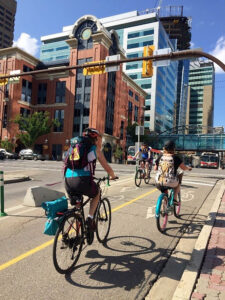 Many Canadian towns and cities witnessed a cycling infrastructure boom towards the late 2000s and early 2010s, and these communities are now seeing the results of that investment. Over the past twenty years, cycling has seen larger increases in places which have invested in on-street bicycle infrastructure. The top neighbourhoods for cycling in Canada in 2016 had almost four times more cycling infrastructure per sq. km than neighbourhoods with less cycling (Manaugh & Winters, publication pending). Additionally, a regular grid pattern of streets can supplement a dedicated cycling network by providing quiet, low-speed alternatives to the main road. Canadian cities and towns that have more four-way intersections have seen larger increases in cycling (Manaugh & Winters, publication pending). In places with circuitous street patterns, multi-use paths can provide more direct active transportation connections between neighbourhoods. The intensification of suburban neighbourhoods can present opportunities to incorporate more of these connections.
Many Canadian towns and cities witnessed a cycling infrastructure boom towards the late 2000s and early 2010s, and these communities are now seeing the results of that investment. Over the past twenty years, cycling has seen larger increases in places which have invested in on-street bicycle infrastructure. The top neighbourhoods for cycling in Canada in 2016 had almost four times more cycling infrastructure per sq. km than neighbourhoods with less cycling (Manaugh & Winters, publication pending). Additionally, a regular grid pattern of streets can supplement a dedicated cycling network by providing quiet, low-speed alternatives to the main road. Canadian cities and towns that have more four-way intersections have seen larger increases in cycling (Manaugh & Winters, publication pending). In places with circuitous street patterns, multi-use paths can provide more direct active transportation connections between neighbourhoods. The intensification of suburban neighbourhoods can present opportunities to incorporate more of these connections.
ACTIONS
- Install good quality, protected, on-street cycling infrastructure.
- Start with a pilot – use temporary materials installed quickly to test a design and address concerns.
- When planning new districts or retrofitting and intensifying suburban shopping centres and big box store complexes, break up block size and ensure there are convenient active transportation connections.
EXAMPLES

- In 2014, Calgary’s City Council voted 8-7 in favour of piloting a 6.5km network of cycle tracks in the city’s downtown for 18 months. The project was implemented in 2015, and evaluated against over 80 performance measures, including safety, bicycle volumes, motor vehicle travel times, economic vitality, and user demographics (age and gender). At the completion of the pilot, council voted 10-4 in favour of making the cycle tracks permanent.
- Mississauga’s Downtown21 Master Plan breaks up large city blocks and parking lots around Canada’s third largest shopping centre to make a more walkable and bikeable community.
- With the construction of a light rail transit line along Eglinton Ave in Toronto, Scarborough’s Golden Mile neighbourhood is being re-imagined. Currently consisting of big box stores, surface parking lots, low rise commercial and industrial buildings, the area is expected to grow rapidly with a mixture of low, mid and tall buildings being added. The City’s Secondary Plan outlines how new streets and active transportation connections will break up the large blocks into a finer grid pattern.
- Between 1996 and 2016, Montréal saw cycling increase by 98%, the highest in Canada. Between 2010 and 2015, the City built 200 km of cycling infrastructure, including the first separated cycle track to go through a major downtown.






